Have you ever heard the phrase “the middle child syndrome”? It refers to the idea that middle children often feel neglected or overshadowed because they are sandwiched between their older and younger siblings. Well, in a way, the middle ear could be seen as the “middle child” of the ear anatomy. While we tend to focus on the outer ear (the visible part) and inner ear (where sound is processed), it’s easy to forget about this crucial intermediary section.
But just like a middle child can bring balance and harmony to a family dynamic, so too does the middle ear play an important role in our hearing abilities. This small but mighty section of our ears acts as a bridge between the outer and inner portions, helping to amplify sound and ensure it reaches our brain properly. In this article, we’ll explore what exactly makes up the middle ear, how it functions, common problems that can occur, and treatment options available. By understanding more about this oft-overlooked area of our ears, you’ll have a greater appreciation for all that goes into your ability to hear sounds around you.
Overview of the Ear Anatomy

Now you’re going to learn about the amazing structure of your hearing mechanism, which will blow your mind! One of the most fascinating aspects of this mechanism is its intricate ear anatomy. The inner workings of the ear are truly remarkable, as they consist of a system of sensory organs that work together to convert sound waves into electrical signals that can be interpreted by the brain.
The ear can be divided into three main parts: the outer ear, middle ear, and inner ear. The outer ear is comprised of the visible portion, known as the pinna or auricle, as well as the auditory canal that leads to the eardrum. The middle ear consists of three tiny bones called ossicles – the malleus (hammer), incus (anvil), and stapes (stirrup) – that transmit vibrations from the eardrum to the inner ear. Meanwhile, the inner ear contains two important structures: the cochlea, which is responsible for converting sound vibrations into nerve impulses; and semicircular canals that help with balance.
Overall, understanding how each part contributes to our sense of hearing is crucial in appreciating how our ears function on a daily basis. It’s fascinating to think about how our body has evolved such an intricate system for processing sound waves! But it’s not just about anatomy – we also need to understand what happens within these structures when we hear sounds. That’s where learning about the function of the middle ear comes in handy!
The Function of the Middle Ear
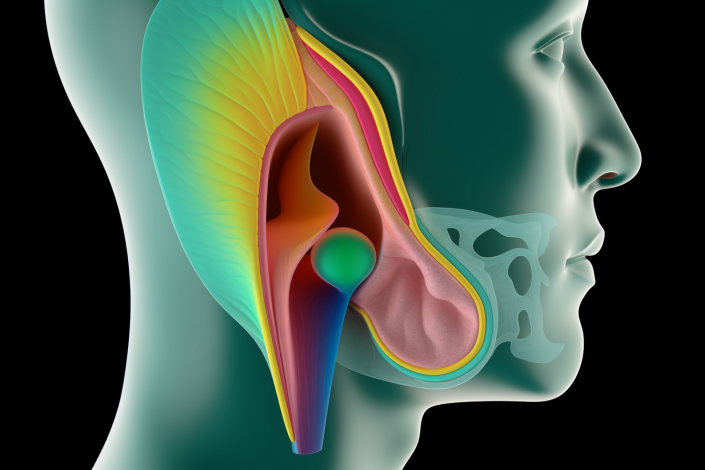
Now that you have a basic understanding of the anatomy of the middle ear, let’s discuss its function. The middle ear plays an important role in amplifying sound waves and transmitting them to the inner ear. It also helps to equalize pressure between the outer and inner ear, which is essential for optimal hearing abilities.
Amplifying Sound Waves
You’ll be amazed to learn that the tiny bones in your ear, known as the ossicles, are capable of amplifying sound waves up to 22 times their original strength! This is due to the amplifying efficiency of the middle ear, which is essential for our ability to hear sounds clearly. The three ossicles – the malleus (hammer), incus (anvil), and stapes (stirrup) – work together like a lever system to increase the force of vibrations from the eardrum and transmit them into the inner ear.
However, this delicate system can be disrupted by various middle ear disorders such as fluid accumulation or damage to any of the ossicles, resulting in hearing loss. It’s important to seek medical attention if you experience symptoms such as pain or pressure in your ears, difficulty hearing, or ringing in your ears. Now that you understand how sound waves are amplified in your middle ear, let’s move on to how they are transmitted into the inner ear.
Transmitting Sound Waves
As you continue to learn about how sound travels through your auditory system, it becomes clear that the process of transmitting sound waves is just as crucial as amplifying them. The middle ear structure plays a vital role in this process, where the vibrations from the eardrum are transmitted through three tiny bones called the ossicles: malleus, incus and stapes. The first bone, malleus, is attached to the eardrum while the last one, stapes, connects to the inner ear through a membrane-covered opening called oval window. These bones work together like a lever system to transfer vibrations from air to fluid-filled cochlea in inner ear.
Sound transmission is not only limited to these bones but also involves some other mechanisms that help in maintaining an optimal environment for hearing. For instance, there is a small muscle attached to each of these ossicles which can contract or relax based on loudness levels of incoming sounds. Additionally, there is also another structure called Eustachian tube that helps equalize pressure between middle and outer ear by allowing air flow into middle ear space. Understanding these finer details about sound transmission can help you appreciate how amazing our ears are at processing complex sounds with great precision and without any conscious effort on our part!
Equalizing Pressure
Don’t forget the importance of equalizing pressure in maintaining optimal hearing ability. Pressure equalization refers to the process of balancing air pressure between the middle ear and the outside environment. This is necessary because changes in air pressure can affect the eardrum’s ability to vibrate, which is responsible for transmitting sound waves to the inner ear.
The Eustachian tube function plays a critical role in this process by connecting the middle ear cavity to the back of your throat. When you swallow or yawn, muscles around this tube contract, opening it up and allowing air to flow into or out of your middle ear until it reaches an equilibrium with external atmospheric pressure. Failure to maintain proper pressure balance can lead to discomfort, pain, and even hearing loss. Now let’s move on to discussing ‘the three tiny bones in the middle ear.’
The Three Tiny Bones in the Middle Ear
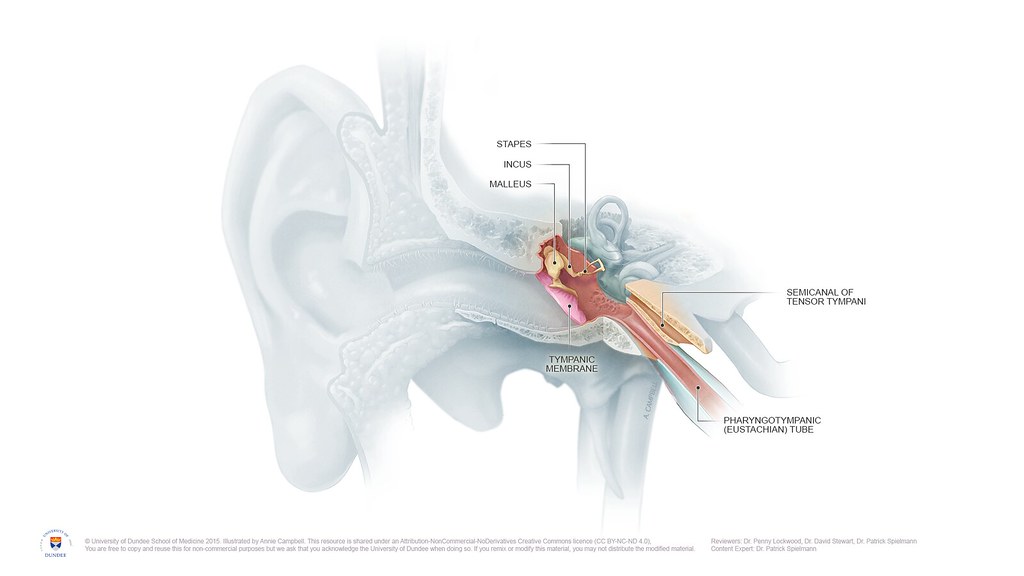
These three little bones work together to amplify sound, allowing us to fully experience the world around us. Known as the ossicles, these tiny bones in the middle ear include the malleus, incus, and stapes. The malleus is connected to the eardrum and transfers vibrations to the incus, which then passes them on to the stapes. The stapes then sends these amplified vibrations to the inner ear.
To give you a better understanding of how these bones function in your ear, here are some key facts:
- The malleus is also known as the hammer bone because it looks like a miniature version of a hammer.
- The incus is sometimes called the anvil bone due to its shape resembling that of an anvil used by blacksmiths.
- Lastly, the stapes is commonly referred to as the stirrup bone since it looks like this type of tool used for horse riding.
The anatomy review and bone structure of these small yet essential bones play a significant role in our hearing ability. As sound waves enter through our outer ear and vibrate against our eardrum, they need amplification for us to perceive them properly. That’s where these three ossicles come into play – without them working together efficiently, we would struggle with hearing even simple sounds.
Now that you have a basic understanding of how these bones work together let’s move on to discussing another crucial aspect of middle ear function: equalizing pressure through the eustachian tube.
The Role of the Eustachian Tube
@ Midjourney AI Image Prompt: /imagine prompt:Create an image of the ear canal leading to the eardrum with the Eustachian tube visible, showing its role in equalizing pressure and draining fluids from the middle ear. –v 5 –ar 3:2 (Note: Use –v 4 if you do not have a paid Midjourney account)
When discussing the role of the Eustachian tube, there are two key points to consider: equalizing pressure and preventing infection. The Eustachian tube is responsible for allowing air to flow from the middle ear to the back of your nose and throat, which helps to regulate pressure. Additionally, it plays a crucial role in preventing infection by draining fluids and keeping bacteria from building up in the middle ear.
Equalizing Pressure
To equalize pressure, you can try swallowing or yawning to activate the muscles in your Eustachian tube and allow air to flow into your middle ear. This is especially important when flying or scuba diving, as changes in altitude can cause discomfort or even damage to your ears if the pressure is not equalized. Other techniques include:
- Chewing gum: This can help stimulate saliva production and swallowing, which helps open the Eustachian tube.
- Valsalva maneuver: Pinch your nose shut and gently blow air out of your nostrils while keeping your mouth closed. This creates pressure that can help push air through the Eustachian tube.
- Toynbee maneuver: Pinch your nose shut and swallow at the same time. This helps open the Eustachian tube by coordinating muscle movements.
- Frenzel maneuver: Close the back of your throat by making a “k” sound, then swallow while pinching your nose shut.
By using these equalizing techniques, you can prevent barotrauma and discomfort in your ears during situations where there are rapid changes in altitude or water pressure. However, it’s also important to take steps to prevent infection in the middle ear, such as avoiding exposure to colds and flu viruses and practicing good hygiene habits like washing hands regularly.
Preventing Infection
Keeping your hands as clean as a surgeon’s and avoiding close contact with sick people will greatly decrease your chances of catching an ear infection. The middle ear is an area that is particularly susceptible to infection due to its location behind the eardrum, which can trap bacteria and viruses. In addition to practicing good hygiene, there are other steps you can take to prevent infection in the middle ear.
One such step is making sure that you or your child receives all recommended vaccinations, including those for influenza and pneumococcal disease. These vaccines help protect against the types of bacteria and viruses that commonly cause ear infections. It’s also important to avoid exposure to secondhand smoke, as this can irritate the lining of the nose and throat and increase the risk of infection. By following these hygiene practices and taking other preventative measures, you can reduce your risk of developing an ear infection.
Now that we’ve covered some tips for preventing infection in the middle ear, let’s dive into how sound waves travel through this crucial part of our auditory system.
How Sound Waves Travel Through the Middle Ear
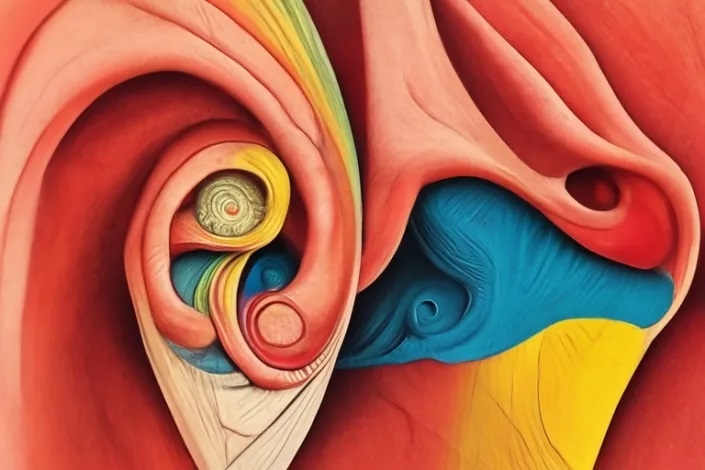
When sound waves travel through the middle ear, they undergo two important processes: compression and decompression. First, as the sound wave enters the ear canal, it causes air molecules to compress or push together. This creates a region of increased pressure that then travels into the middle ear. Next, as the sound wave reaches the eardrum and other structures in the middle ear, these regions vibrate and decompress or move apart from each other. Understanding how sound waves interact with these structures is crucial for hearing and communication.
Sound Wave Compression
You can feel the pressure change as sound waves compress and move through the small space between your eardrum and the tiny bones in your head. Sound wave compression refers to the phenomenon where sound waves push together air molecules causing an increase in pressure. In the middle ear, this increase in pressure is carried by three tiny bones called ossicles – malleus, incus, and stapes – which are connected to each other like a chain. When sound waves reach your eardrum, it vibrates and sets off a chain reaction that causes these bones to vibrate too.
As these bones vibrate, they amplify the sound wave’s energy before passing it along to the inner ear. This amplification effect is necessary because without it, sounds would be too weak for us to hear clearly. The ossicles’ movement also helps match up different frequencies of sounds so that we can distinguish pitch more easily. All of this happens within a fraction of a second, making hearing seem effortless. Next, let’s explore what happens when sound waves decompress as they move towards the inner ear.
Sound Wave Decompression
In the previous subtopic, we talked about how sound waves are compressed in the outer ear. But what happens once those compressed sound waves reach the middle ear? The answer lies in sound wave decompression.
As the compressed sound waves enter the middle ear, they encounter three small bones: the malleus, incus, and stapes. These bones work together to transfer the vibrations of the compressed sound waves into fluid-filled chambers in the inner ear, where they can be transformed into electrical signals that our brain interprets as sound. However, before these vibrations can be transferred into fluid, they must first be decompressed by these tiny bones. This process involves a reversal of compression: as each bone vibrates against its neighbor, it releases some of the pressure built up from compression and allows for a more natural flow of energy through the system.
| Sound Wave Compression | Hearing Loss |
|---|---|
| Occurs in Outer Ear | Can be caused by damage to hair cells in inner ear |
| Involves squeezing molecules closer together | Can result in difficulty hearing certain frequencies or sounds |
| Is necessary for efficient transmission of sound energy | Can often be treated with hearing aids or cochlear implants |
Now that you understand how sound waves are decompressed in the middle ear, let’s move on to discussing how this part of your auditory system works to amplify those same sounds.
How the Middle Ear Works to Amplify Sound
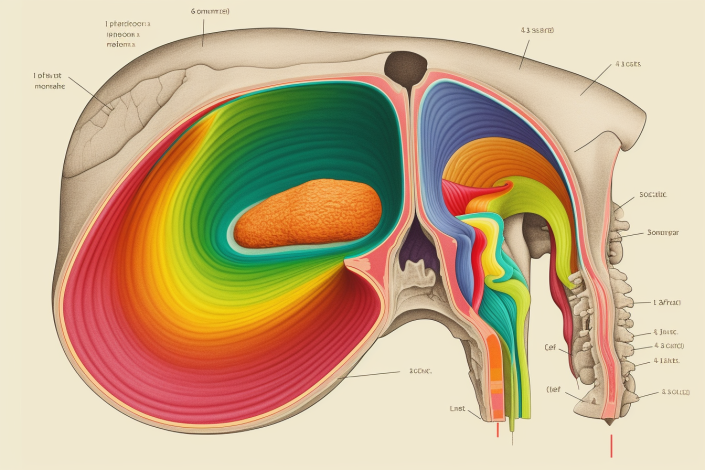
When sound waves enter your ear, they travel through the outer ear and reach the middle ear. Here, the middle ear works as a mechanical amplifier to enhance the sound before it reaches the inner ear. This amplification is achieved through mechanical advantage, lever action, and vibrations that increase the force of sound waves.
Mechanical Advantage
The middle ear amplifies sound, making it easier for us to hear. One of the key mechanisms that contribute to this amplification is called mechanical advantage. This refers to the ability of a system, in this case the middle ear, to multiply force or torque applied to it. The middle ear achieves mechanical advantage through its lever action.
The lever action of the middle ear occurs when sound waves enter the ear canal and strike the eardrum, causing it to vibrate. These vibrations are then transferred through three tiny bones in the middle ear: the malleus, incus, and stapes. The stapes bone acts as a lever by transmitting these vibrations from a large surface area (the eardrum) to a smaller one (the oval window). This change in surface area creates an increase in pressure within the inner ear, which ultimately leads to an increase in our ability to perceive sounds. Lever action is just one way that the middle ear plays a critical role in helping us hear better and understand our environment more fully.
Lever Action
You can think of the lever action in your ear as a tiny seesaw, amplifying sound waves and helping you hear even the slightest whispers amidst a noisy crowd. This mechanical advantage is made possible by the three bones located in the middle ear: the malleus, incus, and stapes. These bones work together to transmit sound vibrations from the eardrum to the inner ear through lever mechanics.
The malleus acts as a lever arm, with one end attached to the eardrum and the other end connected to the incus. The incus then transfers this motion to its connection with the stapes, which serves as another lever arm that pushes against a membrane covering an opening into the inner ear. This system provides an amplification of sound waves by about 1.3 times greater than it would be without this mechanism, allowing us to hear sounds that are too faint for our ears otherwise. Understanding these basic principles of auditory physics helps us appreciate how our ears allow us to experience and enjoy music, conversation, and all kinds of sounds we encounter daily.
From vibrations in our outer ear canal to movements within our inner ear fluid, every step in hearing involves intricate mechanisms that work together seamlessly. So let’s now explore how these amplified vibrations make their way into your inner ear canal!
Vibrations
As sound waves travel through the lever action in your ear, they are amplified and transformed into vibrations that make their way towards the intricate mechanisms of the auditory system. The first stop is at the tympanic membrane, or eardrum, which vibrates in response to these sound waves. This vibration is then passed on to the ossicles – three tiny bones called malleus, incus, and stapes – which work together like a lever to further amplify and transmit these vibrations towards the inner ear.
The ossicles play a crucial role in ensuring that sound waves are faithfully transmitted from the outer ear to the inner ear. Any damage or disruption to this mechanism can result in hearing loss or other middle-ear problems. In fact, common middle-ear problems such as otitis media or glue ear often involve inflammation or fluid accumulation around these structures, leading to disruptions in normal hearing function.
Common Middle Ear Problems
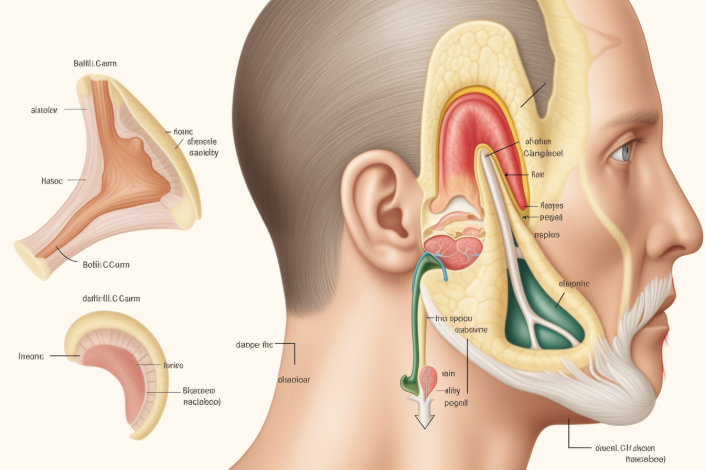
If you’ve ever experienced a sharp pain in your ear or difficulty hearing, it’s possible that you were dealing with a middle ear problem. The most common issues include ear infections, fluid buildup, and ruptured eardrums. These problems can cause discomfort and affect your ability to hear properly, so it’s important to understand the symptoms and seek treatment if necessary.
Ear Infections
Ear infections can be a painful and frustrating experience, but they are a common issue that many people face. They usually happen when the middle ear gets inflamed due to bacteria or viruses. Some of its symptoms include pain, fever, difficulty hearing, and drainage from the ear. Ear infections can occur in both children and adults, but children are more prone to it because their Eustachian tubes are smaller and more horizontal than those of adults.
Prevention strategies for ear infections include washing your hands frequently to prevent the spread of germs, avoiding smoking or being around smokers as secondhand smoke can cause inflammation in the middle ear, getting vaccinated against flu and pneumococcus (a bacterium that causes pneumonia), breastfeeding infants as breast milk contains antibodies that help fight off infections. Treatment options may vary depending on the severity of the infection. Mild cases may go away on their own while others might require antibiotics or pain relievers. In severe cases where fluid buildup occurs behind the eardrum, surgery might be necessary to drain it out.
Fluid buildup behind the eardrum is another common issue associated with middle ear problems. It happens when fluid accumulates in the space between the eardrum and inner ear after an infection or allergies. This condition is called otitis media with effusion (OME) or glue ear because it makes hearing difficult as if there’s glue inside your ears.
Fluid Buildup
Fluid buildup in the space between the eardrum and inner ear can cause hearing difficulties, also known as glue ear. This happens when fluid collects behind the eardrum and creates pressure on the middle ear bones, making it difficult for them to vibrate properly in response to sound waves. There are several causes of fluid buildup, including allergies, infections, or a blockage in the Eustachian tube.
Treatment options for fluid buildup depend on the severity of the condition and underlying causes. In mild cases, doctors may recommend watchful waiting to see if the fluid will clear up on its own. If it persists or causes significant hearing loss, however, more aggressive treatments such as antibiotics or surgical interventions may be necessary. Regardless of treatment approach, it is important to address fluid buildup promptly to prevent further complications such as ruptured eardrums.
Speaking of ruptured eardrums…
Ruptured Eardrum
A ruptured eardrum can be a painful and alarming experience, but there are ways to treat the condition and prevent further complications. A common cause of a ruptured eardrum is exposure to loud noises or sudden changes in pressure, like during air travel or scuba diving. Other causes include infections, injury from objects being inserted into the ear canal, and head trauma.
Symptoms of a ruptured eardrum may include pain, ringing in the ear, hearing loss, dizziness, and fluid discharge from the ear. Treatment options depend on the severity of the rupture and may include antibiotics for any infection present, pain management medication like acetaminophen or ibuprofen, and sometimes surgery if necessary. It is important to take proper care at home by avoiding water exposure to the affected ear to prevent further infection or damage. Healing time for a ruptured eardrum varies depending on severity but typically takes several weeks. Complications can arise if left untreated such as hearing loss so it’s crucial to seek medical attention promptly. Ear protection should also be used around loud noises or when traveling by air.
Now that you understand more about what a ruptured eardrum is and its causes and symptoms let’s dive into some treatment options for middle ear problems without delay!
Treatment Options for Middle Ear Problems
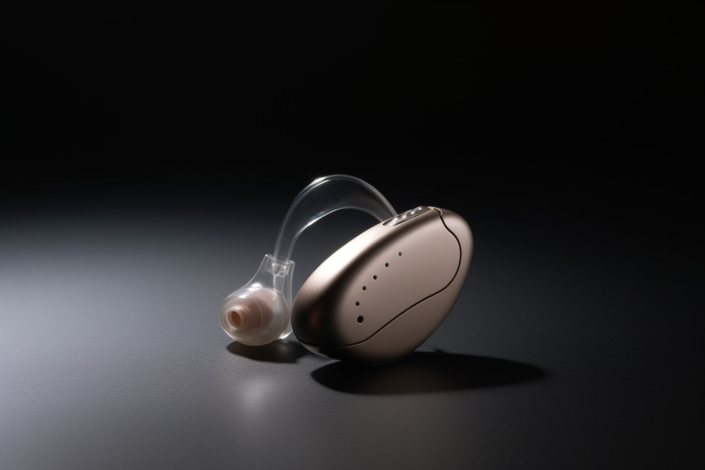
You can explore a range of options to address issues with the middle ear, which is crucial in connecting the sounds you hear to your brain. If you suffer from chronic infections or fluid buildup, antibiotics and steroid medications can help reduce inflammation and eliminate infection. In some cases, surgical procedures such as tympanoplasty or myringotomy may be necessary to repair damage caused by trauma or disease.
Alternative therapies like chiropractic treatments or acupuncture have also been suggested for treating middle ear problems, but their effectiveness remains unclear. It’s important to discuss any alternative therapy options with your doctor before trying them out on your own.
If all non-surgical options fail, surgery may be an option. The type of surgery required will depend on the specific issue and severity of your condition. Generally speaking, surgical interventions aim to restore hearing by repairing damaged structures within the middle ear that may be preventing sound from reaching the inner ear.
As you consider treatment options for your middle ear problems, it’s important to work closely with a qualified medical professional who can guide you through the process. While there are many different approaches available for addressing these issues, each individual case is unique and requires careful consideration before deciding on a course of action. Ultimately, finding the right solution can potentially restore your hearing and improve your quality of life significantly. In conclusion: The importance of the middle ear in hearing cannot be overstated; it plays a vital role in transmitting sound waves from external sources into electrical signals that our brains interpret as meaningful sounds.
Conclusion: The Importance of the Middle Ear in Hearing
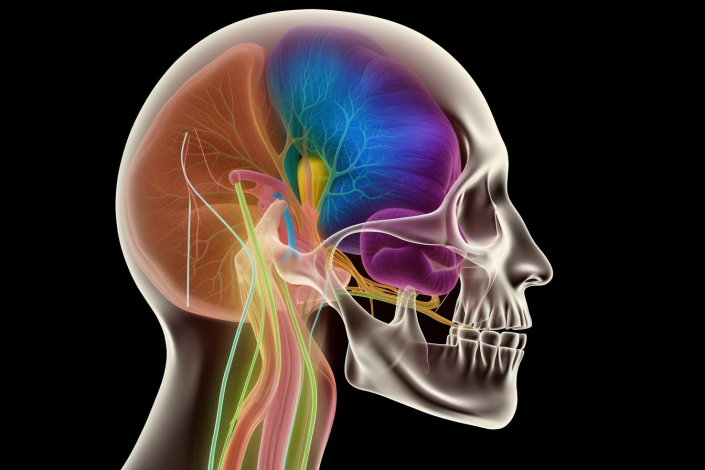
Now that you are aware of the various treatment options available for middle ear problems, let’s delve deeper into the importance and functionality of this crucial part of your auditory system. The middle ear plays a vital role in hearing, as it acts as a bridge between the outer and inner ear. It consists of three small bones – the malleus, incus, and stapes – which work together to amplify sound waves before sending them to the inner ear.
One of the primary functions of the middle ear is to protect your inner ear from damage due to loud noises by reducing their intensity. This is achieved through a reflex called the acoustic reflex, which contracts muscles in your middle ear in response to loud sounds. Additionally, it also helps with sound localization by differentiating between sounds coming from different directions based on differences in time and intensity.
Overall, it is clear that without proper functioning of the middle ear, our ability to hear would be severely compromised. Therefore, it is essential to take care of our ears through regular check-ups and seeking medical attention when experiencing any hearing-related issues. By understanding how each part of our auditory system works and its significance in hearing, we can work towards preserving our hearing health for years to come.
Frequently Asked Questions
How does the middle ear affect balance and equilibrium?
To maintain balance control, your body relies on something called the vestibular system, which is located in your inner ear. This system is responsible for detecting changes in head position and movement, and sending signals to the brain that help you stay upright and steady. However, the middle ear also plays a crucial role in this process by amplifying sound waves and transmitting them to the inner ear. When there is damage or dysfunction in the middle ear, it can affect how well your vestibular system functions and lead to problems with balance and equilibrium. So while the focus may be on the inner ear when it comes to balance control, don’t underestimate the importance of a healthy middle ear as well.
Can middle ear infections cause permanent hearing loss?
You may be surprised to learn that middle ear infections can actually cause permanent hearing loss. It’s a scary thought, but there are ways to prevent this from happening. The best prevention method is to practice good hygiene, such as washing your hands frequently and avoiding contact with people who have colds or other respiratory infections. If you do get an ear infection, seek medical treatment as soon as possible. Antibiotics are often prescribed to help clear up the infection and prevent any damage from occurring. In some cases, surgery may be necessary if the infection has caused significant damage. While it can be concerning, knowing about these prevention methods and treatments can help you protect your hearing in the long run.
Are there any lifestyle changes that can prevent middle ear problems?
If you want to prevent middle ear problems, there are several healthy habits and preventive measures you can take. First, make sure to wash your hands frequently to avoid spreading germs that can cause infections. Additionally, try to avoid exposure to loud noises or wear ear protection when necessary, as this can help protect the delicate structures of the middle ear. Maintaining a healthy diet and staying hydrated can also boost your immune system and reduce your risk of developing infections. Finally, if you or someone in your household is prone to allergies, taking steps to keep allergens under control can also help prevent middle ear issues. By adopting these simple lifestyle changes, you may be able to reduce your risk of experiencing painful and potentially damaging middle ear problems in the future.
How do hearing aids work with the middle ear to improve hearing?
Hearing aid technology is designed to work with the intricate anatomy of the middle ear. The device consists of a microphone that captures sound waves from the environment, which are then amplified and sent through a speaker into the ear canal. This process helps compensate for any hearing loss caused by damage or abnormalities in the middle ear. The aids can also be programmed to adjust to different environments, making it easier to hear in noisy places. Thanks to advances in technology, modern hearing aids are smaller, more discreet, and offer a wider range of features than ever before. They have become an invaluable tool for people suffering from hearing loss and continue to improve as research into middle ear anatomy progresses.
What is the relationship between the middle ear and tinnitus?
Do you suffer from a constant ringing or buzzing in your ears? This is known as tinnitus, and it can be caused by various factors such as exposure to loud noise, ear infections, and hearing damage. Although the origin of tinnitus can be traced back to the inner ear, the middle ear also plays a role in its development. Damage to the tiny hair cells in the middle ear can disrupt auditory signals, leading to phantom sounds that persist even when there’s no external source of noise. While there’s currently no cure for tinnitus, treatments such as sound therapy and cognitive behavioral therapy have been shown to reduce its impact on daily life. If you suspect that your tinnitus is related to hearing damage or issues with your middle ear, it’s important to seek professional help from an audiologist or ENT specialist.
Conclusion
So, now you know that the middle ear is an incredibly important part of your hearing system. It’s the bridge between the outer and inner ear, and without it, sound waves would not be able to reach your inner ear where they are ultimately processed into meaningful sounds.
Ironically, despite its importance, the middle ear is often overlooked or taken for granted. We tend to only pay attention to it when something goes wrong, such as when we experience pain or temporary hearing loss due to an infection or fluid buildup in the middle ear. But by understanding how the middle ear works and what can go wrong with it, we can better appreciate this vital component of our hearing system and take better care of our ears overall. So next time you hear a sound that brings you joy – whether it’s music, laughter or simply birds chirping outside – take a moment to thank your amazing middle ear!